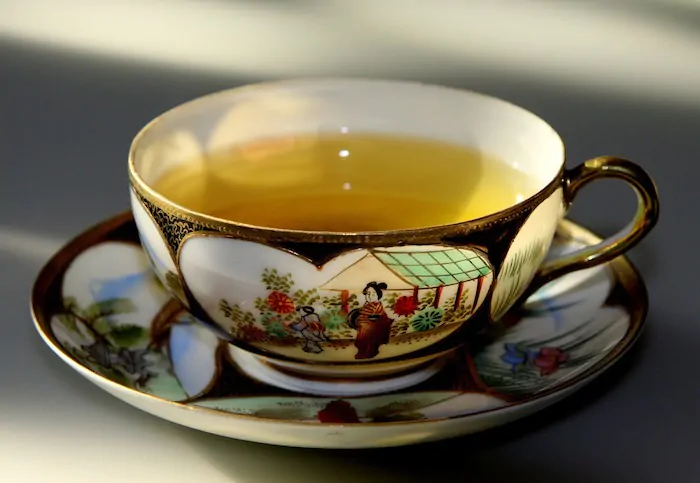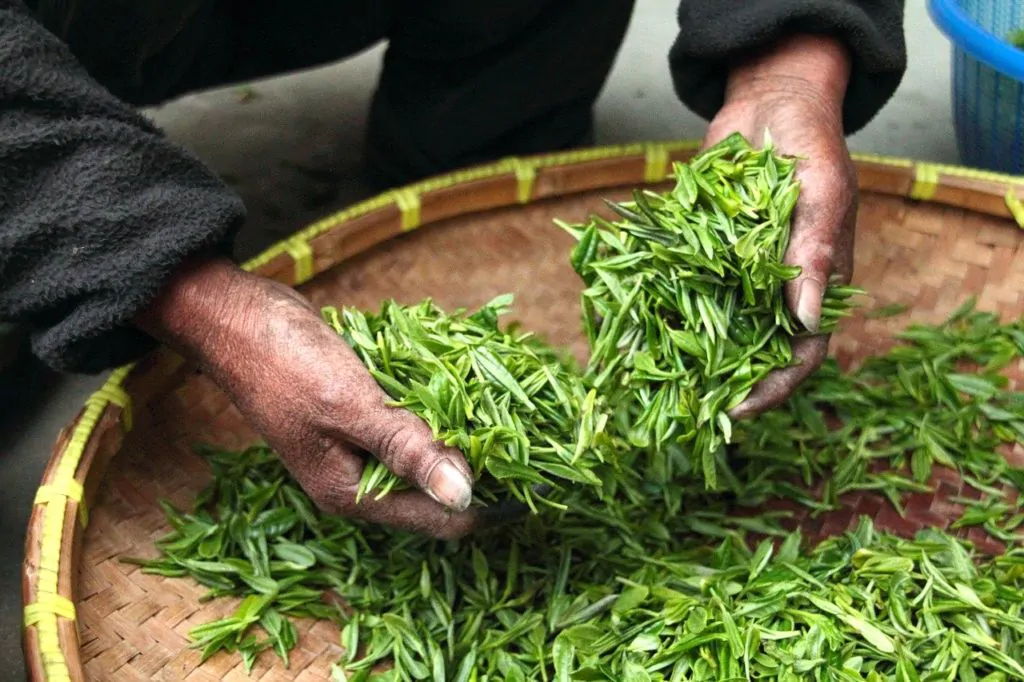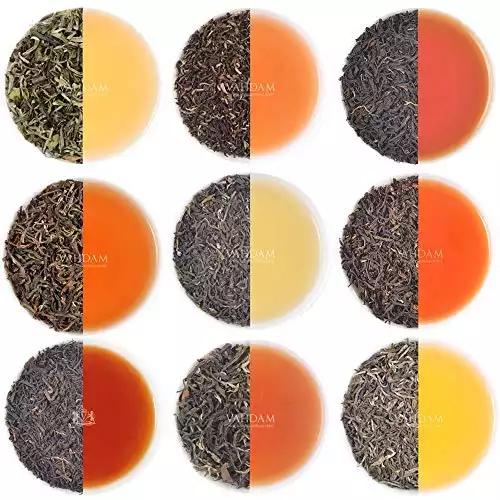Do you find the taste of tea to be too strong or too bland? Try adding your favorite coffee creamer to it to help make it more enjoyable. Read on to find out what other benefits when you put coffee creamer in tea.

If you are a coffee drinker who enjoys the indulgent, creamy, sweet taste of coffee creamer in your coffee, and you also drink tea, it may cause you to wonder if adding coffee creamer to your tea will also make for an indulgent hot drink.
Or perhaps, like some coffee drinkers, you simply want the caffeine and health benefits of tea but are not too keen on the taste, in which case, you may wonder if you can add coffee creamer to your tea to help make it more drinkable.
In either case, you should know that yes, you can add coffee creamer to your tea for a rich cup of warm goodness that can be consumed anytime you want to re-energize or just sit back, relax, and unwind after a long, trying day.
Adding Coffee Creamer To Tea
Because the flavor profile differs from tea to tea, some teas may produce a stronger taste after steeping, which some drinkers may find unpleasant. Additionally, when some teas, such as green teas, are steeped at too high of a temperature or for too long, they can become extremely bitter because it allows more of the tea’s tannins to be released, which can ruin the taste.
However, adding coffee creamer to strong or bitter tea can add richness and flavor that helps mask the taste and make the tea more drinkable. Or it can simply be added to customize your tea like your favorite coffee to help make it more of a treat.
On the other hand, herbal teas have a mild, more delicate flavor; therefore, they may be more enjoyable on their own. However, if you are like some people who find non-caffeinated teas a bit too bland, adding coffee creamer to your tea can also help spruce up the taste.

In the meantime, some tea drinks, such as bubble tea, tea lattes, and chai tea, all call for adding milk to tea; however, coffee creamer can be used in place of milk for a more exciting drink. In some regions, such as the UK, milk is also often added to English Breakfast Tea for added pleasure, so you can also try substituting milk for coffee creamer for a more decadent way to start the day.
In the end, the choice to add coffee creamer to your tea is totally up to the tea drinker. However, should you choose to take your tea with coffee creamer, be sure to experiment with different teas, coffee creamer flavors, and coffee creamer amounts to come up with the best concoction for you. You might also be interested in our English Breakfast Tea Vs. Orange Pekoe guide.
Other Benefits Of Adding Coffee Creamer To Tea
Just like adding milk to coffee helps buffer its acidic effects on your teeth, adding coffee creamer to tea helps provide the same benefits, as tea also contains acidic compounds that can eat away at your tooth enamel.
Furthermore, some darker teas, such as black tea and rooibos tea, can also stain your teeth like coffee, so the addition of coffee creamer, even if it’s just a splash, also helps prevent the tea from staining your teeth.
Adding coffee creamer to your tea also helps make it look more appealing, which studies show also helps make the tea taste better, so you slow down and enjoy it completely.
The creamer can even be added to a milk frother and then used to also top your tea with a bit of latte art for an even more quality-looking cup of tea that is sure to impress your friends and family.
When preparing hot tea, adding coffee creamer can also be added to help cool down the tea, which helps prevent scorching your tongue, the inside of your mouth, as well as the rest of your body in the event that it spills.
Opting for non-dairy coffee creamer is also great for those who are allergic to milk or who are lactose intolerant but still prefer a creamy addition to their tea.
If you are following a low-calorie diet, be sure to use coffee creamer in moderation because the calories can add up.
How Teas Get Their Taste
Like coffee, tea also contains acidic compounds, mainly polyphenols, that affect the tea’s flavor, aroma, and health benefits once it is steeped. However, the chemical composition of polyphenols differs with each type of tea, which is ultimately determined by the degree of oxidation during the processing of the fresh tea leaves.
Polyphenols are most potent in the fresh leaves that are still attached to the thriving plant, which means it also then that the tea at its peak flavor. However, once the tea leaves are removed from the plant, they begin to undergo oxidation, which breaks down the polyphenols in the leaves into various new compounds, including thearubigins and theaflavins, which are tannins that give the tea an intense flavor and bitter taste.

Therefore, the degree of oxidation the tea leaves undergo during processing will ultimately determine the chemical composition of the tea and hence its flavor. For instance, black teas are processed in a way that allows for complete oxidation, which means it is left with high amounts of thearubigins and theaflavin, which give it its dark color and strong taste.
On the other hand, white, green, and yellow teas undergo little oxidation during processing; therefore, most of the polyphenols are still present, which produces a lighter color tea with a milder flavor that is more true to the leaves natural taste.
And then there are other teas, such as oolong teas, that are allowed to semi-oxidize during processing, which means they have a lower concentration of tannins than black tea but a more intense flavor than green and white teas.
To control the amount of oxidation the leaves undergo during processing, tea makers apply heat to the leaves once they are picked to help alter the chemical reaction with oxygen, thus enabling them to control the flavor of the tea.
The environment in which the tea plant is grown, the leaves used, the time of harvesting, and the farming practices can also affect the taste of tea.
For instance, some popular caffeinated teas, such as white teas and green teas, are derived from the Camellia Sinesis plant, which is native to China, while other popular caffeinated teas, including black teas, such as Assam teas, Nilgiri teas, and chai teas, as well as Darjeeling teas and some oolong teas, come from the Camilla Sinesis Assamica plant, which is native to Northern India.
On the other hand, rooibos tea, which is a popular non-caffeinated tea, also known as an herbal tea, is derived from the Aspalathus linearis plant, which is native to South Africa, and chamomile tea, which the main ingredient in the popular “Sleepytime” tea, comes from the Asteraceae plant, which is native to Egypt but can also be found in other parts of the world, including South Africa, India, South America, and Australia.
See also:
CAN YOU PUT MATCHA POWDER IN COFFEE?
CAN YOU PUT HONEY IN COFFEE?
Some Benefits Of Tea
The polyphenols in tea have antioxidant properties, which have been shown to provide many health benefits to tea drinkers, including helps protect against heart disease, some cancers, and stroke. It has also been shown to help prevent arthritis and other inflammatory diseases, as well as some neurodegenerative disorders, such as Alzheimer’s disease.
Tea also contains caffeine, depending on the type, which has been shown to improve brain function, mental focus, and memory. Meanwhile, teas derived from the Camellia Sinesis plant, such as white and green teas, contain an amino acid called L-theanine, which helps promote relaxation.
Can You Put Coffee Creamer In Tea: Related Questions
What is the Difference Between Adding Coffee Creamer to Your Tea vs. Milk?
Milk has a different texture than coffee creamer, so adding milk to your tea will not produce the same results. In fact, many people report that when adding milk to their tea, because of its thinner consistency, it tends to make the tea too watery, especially when adding lower-fat milk, such as skim milk.
Since tea is not as dense or as strong as coffee, it waters down a lot more than coffee, so adding milk to it can make it look and taste more like milky water, especially when adding it to more delicate teas, such as Darjeeling. However, coffee creamer has a thicker consistency; therefore, it adds a creamier texture to tea, which makes it more rich and satisfying.
Vahdam Teas has been featured by Forbes, PopSugar, GMA, O Magazine, Reader's Digest, USA Today etc. in their 2019 Holiday Gift Guides. Vahdam Teas is the winner of the prestigious SOFI award 2018 & 2019. Additionally, it won 6 Awards at the 2019 World Tea Championships.
Because it is so thick, be sure to add just a splash of it to your tea to avoid overpowering the natural taste, except perhaps with chai tea, which has other spicy flavors that will still shine through.
If you do opt to add milk to your tea instead of coffee creamer, try thicker, creamier milk, such as whole milk, cream, or almond milk for best results.
What is the Difference Between Tea Bags, Whole Leaf, and Loose Leaf Tea?
Tea is available in tea bags, whole-leaf, and loose-leaf forms, and which you choose will affect the amount of flavor released.
For instance, standard tea bags are comprised of mainly tea pieces and dust; therefore, it contains less essential oils, which can give it a dull taste. The way it is packaged also affects the freshness, so it can also have a stale taste.
However, whole-leaf tea bags are comprised of the whole tea leaf, which means more of the essential oils are still present, so it produces a more flavorful tea. Meanwhile, a loose-leaf tea is not steeped in a teabag, which allows more water to flow through the leaves, yielding more flavors, vitamins, minerals, and aromas from the leaves.
What are Some Popular Uses for Tea?
Tea has many uses, depending on the type. For instance, herbal teas, such as chamomile and hibiscus, are most commonly used to help promote sleep and relaxation.
Dandelion tea, another popular tea, is often used to help soothe various digestion issues, and echinacea tea is shown to help boost the immune system. Meanwhile, green tea is popular for its weight loss benefits.

